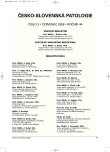A Comparison of RT-PCR and FISH Techniques in Molecular Diagnosis of Ewing’s Sarcoma in Paraffin-Embedded Tissue
Authors:
A. Berková 1; P. Dundr 2; C. Povýšil 2; Š. Melčáková 2; D. Tvrdík 2
Authors‘ workplace:
Institute of Clinical Biochemistry and Laboratory Diagnostics and 2Institute of Pathology, 1st Faculty of Medicine, Charles University and General Faculty Hospital, Prague, Czech Republic
1
Published in:
Čes.-slov. Patol., 44, 2008, No. 3, p. 67-70
Category:
Original Article
Overview
Ewing’s sarcoma is relatively uncommon tumor representing 6-8 percent of malignant bone tumors with variable morphology. Cytogenetically, Ewing’s sarcomas are characterized by a specific reciprocal chromosomal translocation t(11;22)(q24;q12). The presence of this chromosomal translocation has been detected in approximately 85 percent of the cases. The translocation results in the fusion of EWS gene from chromosome 22 to FLI1 gene at 11q24 which is a member of ETS family of transcription factors. In this study we performed a comparison of two molecular diagnostic strategies, namely RT-PCR and FISH, in fresh, frozen and formalin-fixed paraffin-embedded tissues. We conclude that FISH is a more sensitive technique than RT-PCR for the diagnosis of Ewing’s tumors in formalin-fixed paraffin-embedded tissue. In conclusion, molecular pathology techniques, using reverse transcription-polymerase chain reaction (RT-PCR) and/or fluorescence in situ hybridization (FISH) are valuable diagnostic tools for evaluation of undifferentiated small round-cell tumors like Ewing’s sarcoma.
Key words:
Ewing’s sarcoma – chromosomal translocation – RT-PCR – FISH
Sources
1. Adams, V., Hany, M.A., Schmid, M., Hassam, S., Briner, J., Niggli, F.K.: Detection of t(11;22)(q24;q12) translocation breakpoint in paraffin-embedded tissue of the Ewing’s sarcoma family by nested reverse transcription-polymerase chain reaction. Diagn. Mol. Pathol., 5, 1996, s. 107-113.
2. Bertolotti, A., Melot, T., Acker, J., Vigneron, M., Delattre, O., Tora, L.: EWS, but not EWS-FLI-1, is associated with both TFIID and RNA polymerase II: interactions between two members of the TET family, EWS and hTAFII68, and subunits of TFIID and RNA polymerase II complexes. Mol. Cell. Biol., 18, 1988, s. 1489-1497.
3. Bovee, J.V., Devilee, P., Cornelisse, C.J., Schuuring, E., Hogendoorn, P.C.: Identification of an EWS-pseudogene using translocation detection by RT-PCR in Ewing’s sarcoma. Biochem. Biophys. Res. Commun., 213, 1995, s. 1051-1060.
4. Delattre, O., Zucman, J., Plougastel, B., et al.: Gene fusion with an ETS DNA-binding domain caused by chromosome translocation in human tumours. Nature, 359, 1992, s. 162-165.
5. Felsch, J. S., Lane, W. S., Peralta, E. G.: Tyrosine kinase Pyk2 mediates G-protein-coupled receptor regulation of the Ewing sarcoma RNA-binding protein EWS. Curr. Biol., 9, 1999, s. 485-488.
6. Graves, B.J., Petersen, J.M.: Specificity within the ets family of transcription factors. Adv. Cancer Res., 75, 1998, s. 1-55.
7. Hattinger, C.M., Potschger, U., Tarkkanen, M.: Prognostic impact of chromosomal aberrations in Ewing tumours. Br. J. Cancer, 86, 2002, s. 1763-1769.
8. Hisaoka, M., Tsuji, S., Morimitsu, Y, et al.: Molecular detection of EWS-FLI1 chimeric transcripts in Ewing family tumors by nested reverse transcription-polymerase chain reaction: application to archival paraffin-embedded tumor tissues. APMIS, 107, 1999, s. 577-584.
9. Jeon, I.S., Davis, J.N., Braun, B.S., et al.: A variant Ewing’s-sarcoma translocation (7;22) fuses the EWS gene to the ETS gene ETV1. Oncogene, 10, 1995, s. 1229-1234.
10. Knoop, L. L., Baker, S. J.: The splicing factor U1C represses EWS/FLI-mediated transactivation. J. Biol. Chem., 275, 2000, s. 24865-24871.
11. Kovar, H., Jug, G., Hattinger, C., et al.: The EWS protein is dispensable for Ewing tumor growth. Cancer Res., 61, 2001, s. 5992–5997.
12. Peter, M., Couturier, J., Pacquement, H., et al.: A new member of the ETS family fused to EWS in Ewing tumors. Oncogene, 14, 1997, s. 1159–1164.
13. Povýšil C., Matějovský Z.: Ultrastructure of Ewing’s tumour. Virchows Arch., 374, 1977, s. 303-316.
14. Presant, C.A., Russel, W.O., Alexander, R.W., Fu, Y.S.: Soft-tissue and bone sarcoma histopathology peer review: the frequency of disagreement in diagnosis and the need for second pathology opinions. J. Clin. Oncol., 4, 1986, s. 1658-1661.
15. Rabbitts, T.H.: Chromosomal translocation in human cancer. Nature, 372, 1994, s. 143-149.
16. Rossow, K. L., Janknecht, R.: The Ewing’s sarcoma gene product functions as a transcriptional activator. Cancer Res., 61, 2001, s. 2690-2695.
17. Sandberg, A., Turc-Carel, C.: The cytogenetics of solid tumours: relation to diagnosis, classification and pathology. Cancer, 59, 1987, s. 387-395.
18. Selleri, L., Giovannini, M., Romo, A., et al.: Cloning of the entire FLI1 gene, disrupted by the Ewing’s sarcoma translocation breakpoint on 11q24, in a yeast artificial chromosome. Cytogenet. Cell Genet., 67, 1994, s. 129-136.
19. Sorensen, P.H.B., Lessnick, S.L., Lopez-Terrada, D., Liu, X.F., Triche, T.J., Denny, C.T.: A second Ewing’s sarcoma translocation, t(21;22), fuses the EWS gene to another ETS-family transcription factor, ERG. Nature Genet., 6, 1994, s. 146-151.
20. Tvrdík, D., Svatošová, J., Dundr, P., Povýšil, C.: Molecular diagnosis of synovial sarcoma: detection of SYT-SSX1/2 fusion transcripts by RT-PCR in paraffin-embedded tissue. Med. Sci. Monit., 11, 2005, s. MT1-7.
21. Urano, F,. Umezawa, A., Hong, W., Kikuchi, H., Hata, J.: A novel chimera gene between EWS and E1A-F, encoding the adenovirus E1A enhancer-binding protein, in extraosseous Ewing’s sarcoma. Biochem. Biophys. Res. Comm., 219, 1996, s. 608–612.
22. Weiss, S.W.: WHO: Histological typing of soft tissue tumors. Berlin: Springer. 1994, s. 298-300.
23. Yang., L., Chansky, H.A., Hickstein, D.D.: EWS/Fli-1 fusion protein interacts with hyperphosphorylated RNA polymerase II and interferes with serine-arginine protein-mediated RNA splicing. J. Biol. Chem., 275, 2000, s. 37612-37618.
24. Zucman, J., Delattre, O., Desmaze, C., et al.: Cloning and characterization of the Ewing’s sarcoma and peripheral neuroepithelioma t(11;22) translocation breakpoints. Genes Chromosomes Cancer, 5, 1992, s. 271-277.
Labels
Anatomical pathology Forensic medical examiner ToxicologyArticle was published in
Czecho-Slovak Pathology

2008 Issue 3
Most read in this issue
- Thrombotic Microangiopathies: Thrombotic Thrombocytopenic Purpura (TTP) and Hemolytic Uremic Syndrome (HUS). Morphological Features, Differential Diagnosis, and Pathogenesis. Review Article
- Spontaneus Abortion Caused by Listeria monocytogenes – Report of Three Cases
- Expression of CD34 and CD117 in Juxtaglomerular Cell Tumor of Kidney
- Fibrosis Identified in the Bone Marrow Biopsies of Patients with Essential Thrombocythemia: its Incidence and Significance for the Differential Diagnostic Considerations
